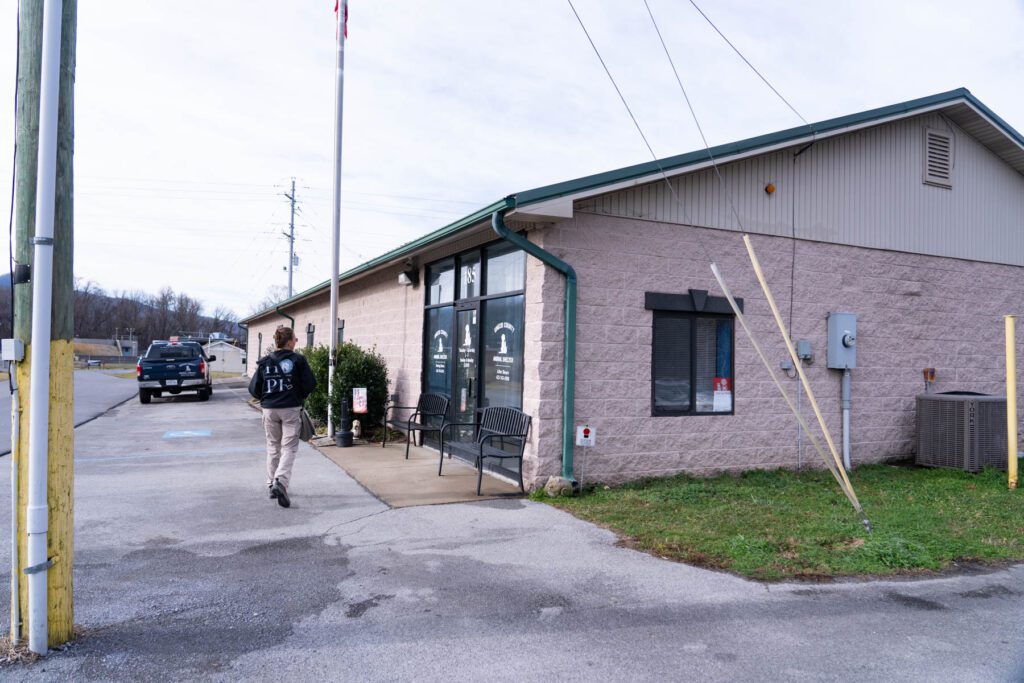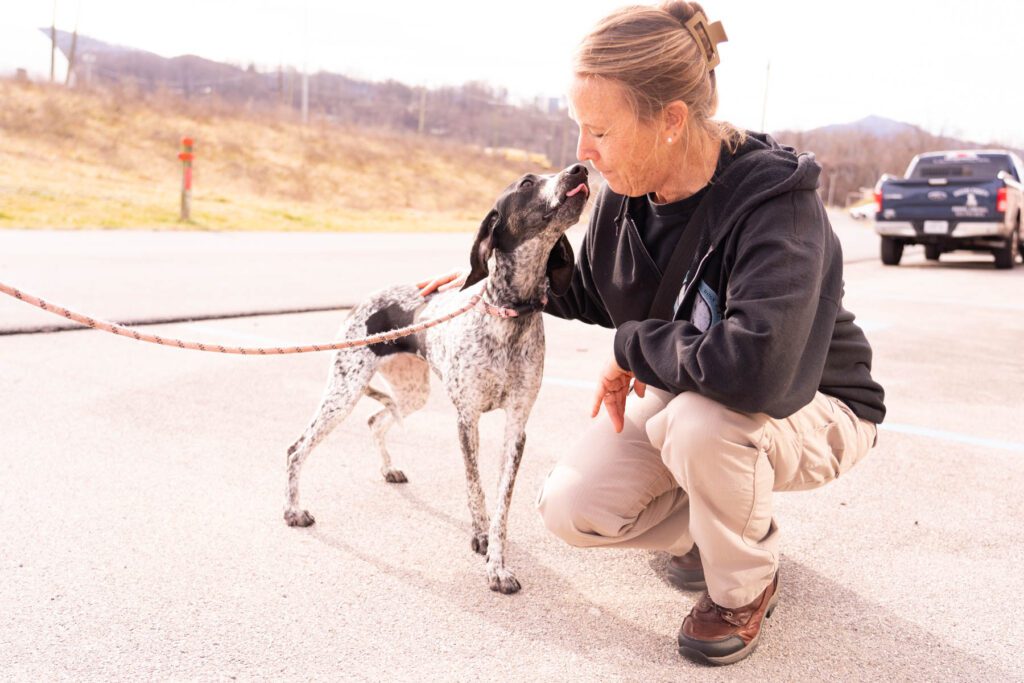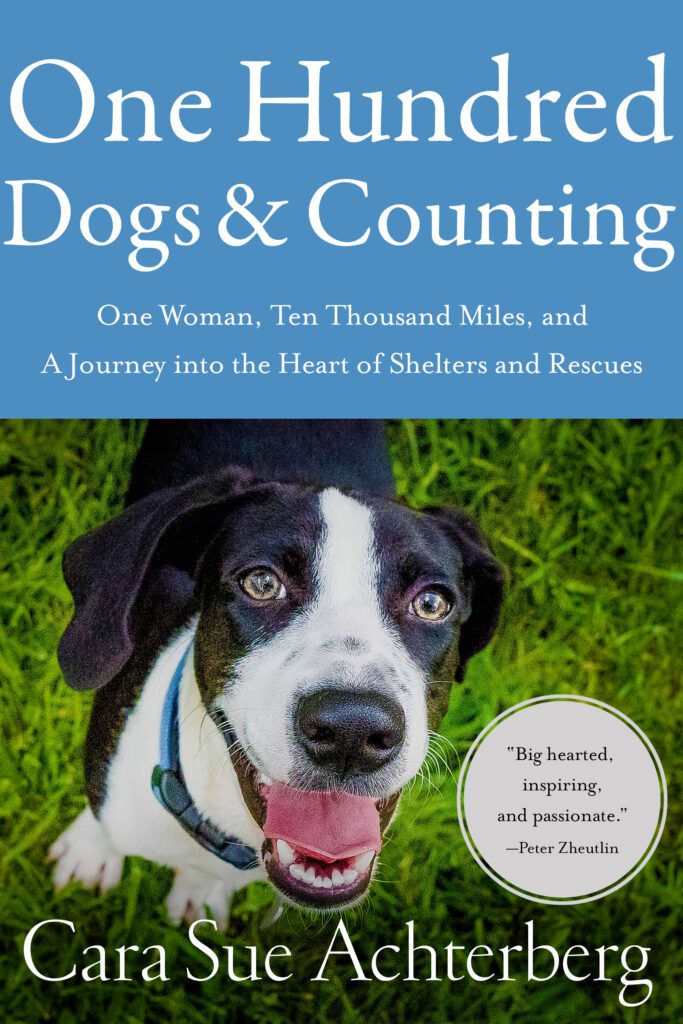Until 2004, the Unicoi County Animal Shelter on the eastern edge of Tennessee was a traditional dog pound—no adoptions, very few live releases. Enter Ellen, a current board member who changed the story and helped that dog pound become a real shelter. As she says, ‘It was an overnight success that was twenty years in the making.’

Now the shelter rarely euthanizes and only for medical or behavioral reasons. Last year they handled 700 animals, but this year, Pam, the shelter director, can already say those numbers will go up. Like so many shelters, they are seeing an influx of animals. Most of their animals come in through the shelter’s animal control officer, Cody. Owner surrenders are put on a waiting list until there is space.
The shelter has 27 kennels, plus a bank of small dog kennels. They are currently full and even have a few smaller dogs in stacked wire crates. They stay full, Ellen assured me.
Unicoi is technically a municipal shelter. It sits on county-owned land. It is also a 501(c)(3) nonprofit with a board made up of residents appointed by the three municipalities the shelter serves – the city of Unicoi, the city of Erwin, and Unicoi County. The municipalities pay a portion of the shelter’s payroll (for two full-time and eight part-time employees), but Pam is responsible for raising the additional $200,000 it takes to operate the shelter each year.
Pam has worked at the shelter for five years, serving as director for the last year. Originally, she worked as a cat cleaner after she came to the shelter to adopt a hound dog and fell in love, not just with the dog, but the shelter. Previously, Pam had been working as a department manager for McDonald’s. She has an MBA (and the student loans to prove it).





Cody began work at the shelter as a dog cleaner and has been the ACO for the last three years. In Unicoi, the ACO is a shelter employee and not under the sheriff’s department. Pam’s daughter, Natalie, works part-time at the shelter handling much of the medical needs of the animals.
Two of the board members, Ellen and Stana, a local attorney, joined us for our visit. Stana got involved after adopting a tripod cat named Cabala who became the main attraction in her law office. Cabala has since passed, but now she has Baby Ruth, a kitten she found in a trash can. Both women are very involved in the fundraising side of things, and they help where they can. Ellen told me she’d just taken home three loads of laundry. There is also a Friends of the Shelter group who help with fundraising.
So, to catch you up on this rare, but clearly successful set up… the shelter serves three municipalities that provide the property and a portion of payroll, but it is also a nonprofit with an appointed board that must raise the majority of its budget through fundraising efforts each year.
The shelter holds adoption and fundraising events in the community, and one of the local schools takes two dogs for four hours each Wednesday and Friday as part of a class. There is also a small Humane Society organization that pays a portion of the cost for community animals to be spayed and neutered.
This unique version of public sheltering has worked for twenty years, only because there is such community support and such huge efforts toward fundraising, but one (or at least me) has to wonder how incredible their shelter would be if the money they raise just to keep the lights on and the dogs fed, could instead be used to improve conditions at the shelter.
Currently, the dogs live in narrow cement-sided kennels with an equally small outdoor space connected by guillotine doors. The puppy kennel bank and stacked crates are off to the side of the room, but they are all in the same dark space. The volume and the stress level can be exponential whenever visitors walk through.





While the staff and the handful of volunteers do try to get the dogs out individually to the play yard, there are too many dogs and too few people to meet all their needs. The stress level of the dogs was evident not just in the frantic noise, but in the spinning and lunging dogs as we walked through to take pictures and hand out treats.
The staff clearly loves the dogs and is doing the best they can to keep them happy—with treat buckets hanging outside the doors, Kuranda beds, blankets, and toys, but with so many dogs and so few resources (people and supplies), they can only do so much.






Pam’s dream is to redesign the kennel spaces to make things better for the dogs. We encouraged them to look into programs like Dogs Playing for Life and Shelter Playgroup Alliance. Training staff and volunteers to utilize their play yard for daily playgroups would go a long way toward relieving the stress for many of the dogs.
While they are blessed to have access to several vets and a low-cost spay/neuter clinic, the length of stay for the dogs can sometimes be months, even years. Puddy, a dog scheduled to be adopted the Saturday after our visit had been at the shelter for two years. Both Brother Wolf and Double-Dog Rescue pull from Unicoi, but many of their animals get out through local adoptions.
I think this shelter is only going to get better. They have the key pieces in place – excellent leadership, veterinary access, and community engagement, so they are on their way.





Hopefully, that supportive community will speak up and ask that their tax dollars be used to fully fund the shelter, instead of paying for it via soup sales and online auctions. The money comes from the community one way or another, and relieving the staff of that fundraising burden would free them up to focus on making life better for the animals in their care.
If you’d like to support their work, you can shop the shelter’s Amazon or Chewy wishlists. Or you can donate via Paypal.

Until each one has a home,
Cara
If you want to learn more, be sure to subscribe to this blog. And help us spread the word by sharing this post with others. Visit our website to learn more.
You can also help raise awareness by following/commenting/sharing us on Facebook, Instagram, YouTube, Tik Tok, and the Who Will Let the Dogs Out podcast.
To see our Emmy-nominated, award-winning short documentary, Amber’s Halfway Home, click here. If you’d like to see it on the big screen (along with other short dog films), check out the tour schedule of The Dog Film Festival, currently in art movie houses all over the country.

Learn more about what is happening in our southern shelters and rescues in the book, One Hundred Dogs & Counting: One Woman, Ten Thousand Miles, and a Journey Into the Heart of Shelters and Rescues (Pegasus Books, 2020). It’s the story of a challenging foster dog who inspired me to travel south to find out where all the dogs were coming from. It tells the story of how Who Will Let the Dogs Out began. Find it anywhere books are sold. A portion of the proceeds of every book sold go to help unwanted animals in the south.
For more information on any of our projects, to talk about rescue in your neck of the woods, or become a WWLDO volunteer, please email whowillletthedogsout@gmail.com or carasueachterberg@gmail.com.



Amy
Do tfirget tbe tireless work if Kevin King, tbe orevious shekter director. I live in NC and have bben to this shelter. I send food and money when i can
Oam us doing a great job.